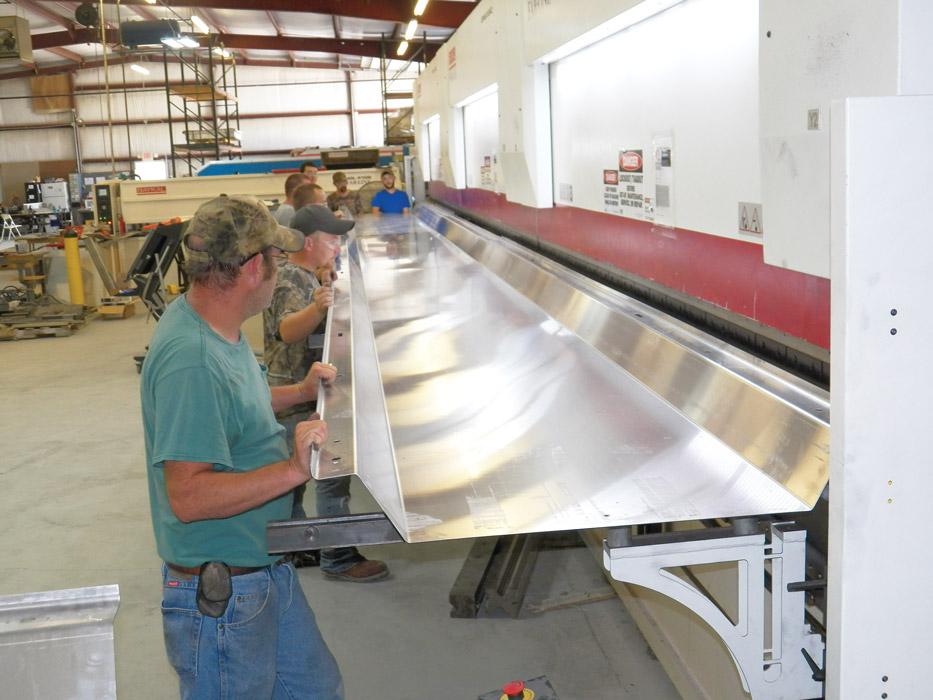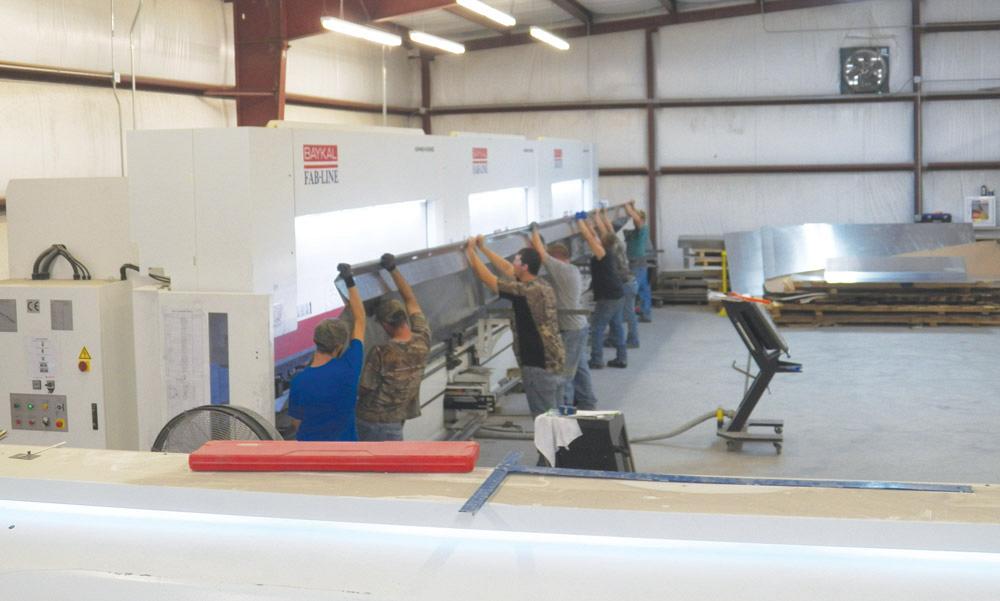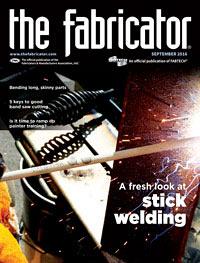Senior Editor
- FMA
- The Fabricator
- FABTECH
- Canadian Metalworking
Categories
- Additive Manufacturing
- Aluminum Welding
- Arc Welding
- Assembly and Joining
- Automation and Robotics
- Bending and Forming
- Consumables
- Cutting and Weld Prep
- Electric Vehicles
- En Español
- Finishing
- Hydroforming
- Laser Cutting
- Laser Welding
- Machining
- Manufacturing Software
- Materials Handling
- Metals/Materials
- Oxyfuel Cutting
- Plasma Cutting
- Power Tools
- Punching and Other Holemaking
- Roll Forming
- Safety
- Sawing
- Shearing
- Shop Management
- Testing and Measuring
- Tube and Pipe Fabrication
- Tube and Pipe Production
- Waterjet Cutting
Industry Directory
Webcasts
Podcasts
FAB 40
Advertise
Subscribe
Account Login
Search
Press brake bending: Forming long and skinny
Shop tackles an untapped niche and more than doubles its head count
- By Tim Heston
- August 29, 2016
- Article
- Bending and Forming

Figure 1
Workers at Phoenix Products form a workpiece that’s nearly 40 feet long in the company’s triplet, or tridem, press brake.
Tom Wilson thinks differently than your typical job shop manager, and there’s a good reason for that. Phoenix Products Inc., the shop he helped build in the mountains of eastern Kentucky, is in the woods. McKee, the nearest town, is about 15 minutes away, but you won’t find technical schools or a large industrial base there.
When Wilson expanded into metal fabrication, he decided to tackle an unusual niche: the cutting and forming of long, narrow parts. The company invested in a press brake that could handle parts as long as 40 feet. It’s actually three 13-ft. press brakes tied together—a triplet, or tridem, system.
Why tackle this unusual niche in metal fabrication? The reason seems counterintuitive, except when put in the context of rural Appalachia. Wilson, along with his wife Peggy Wilson, Phoenix’s CEO, wanted to hire more people.
Drive for Economic Development
A conventional job shop near a metro area, or even a rural one in a region with roots in manufacturing, usually hires as few people as possible. If automation or other technology can help each person provide more value, that’s all the better. Hiring more people, if not an act of last resort, usually isn’t the primary business goal, especially considering the challenges of finding, paying, and retaining highly skilled technical personnel.
Although it takes a lot of engineering and programming expertise to machine a part, Wilson knows that it doesn’t take a lot of labor, especially these days. The operator, working with one or several machines simultaneously, loads a workpiece, calls up the program, closes the door, and runs the job.
Phoenix launched in 1973 as a small kayak manufacturer before concentrating on military work in the mid-1990s, machining composites and eventually metal. The company has machined Sikorsky helicopter parts for years.
“We made a variety of parts for special operations forces, maintenance trainers—mostly composite material, but then we delved into metalworking with some proprietary machine shop products,” Wilson recalled. “Still, we found that machine shop work was not the right answer for bringing employment to the area, because there’s very little labor content. So we looked for alternatives.”
He clarified, however, that hiring and training highly skilled individuals—those who are able to program and set up a 5-axis machining center, for instance—isn’t a bad idea in rural communities. Many think that if a person at a rural shop is trained at 5-axis machining, that person soon will move on to suburbia where multiple companies can compete for his skill. There’s similar thinking when it comes to skilled welders, such as aerospace welders experienced with aluminum.
“The story goes, you train somebody to be an aerospace welder, the first thing they do once they get experience is pack their bags, and go to the big city,” Wilson said. “This isn’t quite so true. If there’s an employment opportunity, and it pays a reasonable wage back in the mountains, then people tend to stay. A lot of people around here don’t want to leave, but they have to leave if there’s no work to support the family.”
Wilson wanted to create jobs, but also knew the market dictates the jobs he could create. The nature of machining work just doesn’t require a lot of people, and if he hired people he didn’t need, especially highly skilled individuals, the business wouldn’t last long.

Figure 2
Workers monitor the workpiece condition during and after forming. They know how to read the piece and ensure angles are within tolerance throughout the length of the bend.
Then, in late 2012, an opportunity from Sikorsky came along that would forever change the direction of the company.
Going Long
A helicopter’s rotary blades need to be shipped and, for obvious reasons, require careful handling. They need long, narrow shipping containers, and the ones Phoenix now produces are made of aluminum, 20 ft. long, 4 ft. deep, and 2 ft. high. They weigh about 300 pounds. It’s all formed on a rarity in metal fabrication, especially stateside: a triplet press brake (see Figure 1), a Baykal system from Fab-Line Machinery. The company worked with FMS Machine Tool Distributors Inc., based in Middleburg Heights, Ohio, to plan for and install the system.
Wilson recalled how FMS Machine Tool President David Saiko visited Phoenix and noticed the limited space, a reason that prevents many machine shops from bringing in any fabrication equipment period, let alone a 40-ft. press brake. Of course, one thing rural Kentucky does have is space.
Wilson drove the machine tool rep to an empty 12,000-sq.-ft. building Phoenix acquired three years earlier, for potential growth, though at the time Wilson didn’t know exactly what that growth would be. (This was one of two spec buildings Phoenix bought; a woodworking business that had planned to occupy them never got off the ground.)
The job for the helicopter-blade container entailed a 20-ft.-wide workpiece, so why invest in a 40-ft. triplet machine? As Wilson explained, making the investment in the triplet would position the company in a truly unusual niche. It’s a small niche, for sure, but one a small company can capitalize on to grow. Customers looking to bend 40-ft.-long workpieces in low to mid volumes don’t have many options.
The machines all can operate independently or in tandem (two brakes) or tridem (three brakes) modes. One master controller can control one, two, or all three brakes together; a second and third controller can handle one or two brakes at once.
The Right Mix of Skill
Wilson refers to the company’s focus as the “long, skinny part niche,” which calls for a mix of employees that, when you consider the nature of U.S. manufacturing, is somewhat unusual. Forming such long workpieces requires a handful of highly skilled individuals to perform engineering work, program, and set up the machine. It also requires a handful of entry-level people to help position the large workpieces for forming.
Phoenix remains a job shop, and none of its work is in volumes high enough to justify material handling automation, particularly for such large workpieces. A fork truck can handle the raw stock up to a point, but a team of operators still need to physically load the blanks into the machine.
Our runs are typically 20 units at a time,” Wilson said. The company forms and fabricates about 15 different products, and each of those products has between 20 and 30 different bent parts. “We do a few of this and a few of that, so we have to have a lot of flexibility.”
Jobs are scheduled and sequenced to minimize the need for lengthy tool changeovers, but when changeovers do happen, they require planning. Their largest tools are 13 ft. long and require a fork truck to handle them. Changeover times vary depending on the job, but some can take one or two hours. “During a typical day, we usually don’t have to change out tools more than once,” Wilson said. “We do a lot of planning.”

Figure 3
The work area near the brake has ample room so that workers can manipulate large workpieces between bends.
The brake does have front workpiece supports that workers use to slide and position these massive pieces against the backgauge. And they use tables and other low-tech material handling aids. But other than that, teams of workers are needed to lift these long, narrow workpieces into position.
Most important, Wilson said, the brake applications require a fair number of semiskilled people (see Figure 2). They may not be able to program the machine, but they can run jobs, inspect the workpieces, and notify the machine programmers when a change needs to be made to, say, accommodate an underbend.
And Then There Were Three
Dreaming up this business strategy was the easy part. Actually implementing it was something else entirely. Phoenix had no experience in fabrication, which had its advantages and disadvantages. Wilson and his team approached sheet metal bending with no preconceptions.
For instance, you might expect an organization without metal fabrication experience to invest in a smaller brake first, then progress to larger, more specialized jobs. But as Wilson saw it, how would a small brake differentiate the company? For Phoenix, differentiation is a necessity for long-term growth; otherwise, why should a company contract with a faraway shop in Appalachia when it could go to the fab shop down the street?
At the same time, the people at Phoenix had no fabrication experience. But they did have focus: to excel at cutting and forming long, narrow workpieces, many of them aluminum. After the machine was installed in June 2013, workers received training from the distributor, and over the next six weeks the new fabrication team essentially “made a lot of scrap metal,” Wilson said, adding that the team learned quickly: how to make adjustments, account for thickness and hardness variations between batches of material, even accounting for environmental factors like temperature changes.
They also had to learn how to work with some extraordinarily long bends. By the end of the year, Phoenix made its first shipment of 20-ft.-long aluminum containers for helicopter blades. “We’ve been producing for Sikorsky and numerous other customers ever since,” Wilson said.
Soon after the company purchased a used turret punch press and a shear, and Phoenix’s fabrication division was up and running.
“I recall people telling us, ‘You’re going from zero to 90 when everyone else is going from zero to 20,’” Wilson said. “‘Are you sure you know what you’re doing?’”
About the People
Although he was new to fabrication, Wilson was a veteran at treading into uncharted territory. He launched Phoenix decades ago, in a place where he essentially had to start from scratch.
“We had significant obstacles launching a business here [in eastern Kentucky], but they can be overcome,” Wilson said. “The people are very good workers. They need to be trained, but that’s what we’ve done. We’ve learned how to bring good people in, train them, and make them excellent for whatever we’re doing.”
Most companies in the area are clustered near interstate highways or rural parkways that wind their way through the mountains. “My wife and I feel very strongly that Appalachia is a good place to locate a business,” he said, adding that “the people are great people.” Although most, if not all, of the locals lack experience, they have strong family ties that keep them rooted in an area where, for many, work is hard to come by.
Today most of the employees in the fabrication area help out in bending in some way. Three people program and set up the machine, six people run the machine and make adjustments, and as many as eight people (and more if needed) help move work into position. Others perform other entry-level work, including grinding and deburring. Working in a high-product-mix environment, most are cross-trained.
The fab shop has an assembly area, and all departments are set up to handle parts up to 40 ft. A large expanse separates assembly from the brake, just so workers have enough space to rotate and manipulate long parts (see Figure 3).
After several years focusing on long-workpiece bends, technicians have learned how to make ever-so-minor adjustments, which become especially critical as the workpiece gets longer. “In our vernacular, 13-ft. pieces are easy,” Wilson said.
He added that the company’s current product mix includes a range of lengths. All three brakes are always in use. Sometimes they’re used separately, sometimes two in tandem with the third brake operating on its own.
Only on occasion do jobs require the use of all three brakes at once for one part, usually just several times a month. Because many think no fabricator can bend such a long piece, especially in low volumes, engineers avoid designing parts that long. Of course, as word gets out, Wilson hopes this situation will change.
Most of the operation’s sheet metal work involves some type of aluminum, from soft aluminums all the way up to hard aluminum like 6061-T6.
Each brake in the triplet system is 265 tons, for a total of 795 tons across the three brakes. The throat between brakes is 16.1 in. deep, which limits the flange length when forming in tandem or tridem mode. Regardless, the system suits the shop’s “long and skinny part” focus.
The fabrication work led to welding, especially aluminum welding, all of which supports the fab shop. Phoenix launched a welding operation two years ago and now employs about 10 welders, all of whom can perform gas metal arc and, especially, gas tungsten arc welding.
They all have been trained by an in-house welding educator. As Wilson pointed out, just like it is for other skilled positions, few experienced welders call eastern Kentucky home. “We don’t find welders here. We make them.”
Fabrication Drives Growth
Over three years Phoenix has transformed itself from a small machine shop to one that gets most of its revenue from fabrication and welding. Along with wet paint coating services, fabrication and welding now make up almost 80 percent of Phoenix’s revenue. The machining side of the business is still growing, just not as quickly as fabrication.
Like a lot of custom fabricators, Phoenix now uses machining, as well as its welding, to support its primary metal fabrication business. It employs 65 people, 40 of whom work in the fabrication and welding shops. Compare that with four years ago, when Phoenix employed just 17 people.
Several years ago, its machining operation was heavily reliant on military work. Today the fab shop has helped to diversify the customer base. About 30 percent of the company’s fabrication work now comes from outside the military sector.
Wilson perhaps summed up his mission best this way: “I came down here to eastern Kentucky to launch a business that was not only very labor-intensive, but also required skill.” The shop’s long-workpiece niche just so happens to require both.
Photos courtesy of Phoenix Products Inc.
About the Author

Tim Heston
2135 Point Blvd
Elgin, IL 60123
815-381-1314
Tim Heston, The Fabricator's senior editor, has covered the metal fabrication industry since 1998, starting his career at the American Welding Society's Welding Journal. Since then he has covered the full range of metal fabrication processes, from stamping, bending, and cutting to grinding and polishing. He joined The Fabricator's staff in October 2007.
Related Companies
subscribe now

The Fabricator is North America's leading magazine for the metal forming and fabricating industry. The magazine delivers the news, technical articles, and case histories that enable fabricators to do their jobs more efficiently. The Fabricator has served the industry since 1970.
start your free subscription- Stay connected from anywhere

Easily access valuable industry resources now with full access to the digital edition of The Fabricator.

Easily access valuable industry resources now with full access to the digital edition of The Welder.

Easily access valuable industry resources now with full access to the digital edition of The Tube and Pipe Journal.
- Podcasting
- Podcast:
- The Fabricator Podcast
- Published:
- 04/16/2024
- Running Time:
- 63:29
In this episode of The Fabricator Podcast, Caleb Chamberlain, co-founder and CEO of OSH Cut, discusses his company’s...
- Trending Articles
Steel industry reacts to Nucor’s new weekly published HRC price

How to set a press brake backgauge manually

Capturing, recording equipment inspection data for FMEA

Are two heads better than one in fiber laser cutting?

Hypertherm Associates implements Rapyuta Robotics AMRs in warehouse

- Industry Events
16th Annual Safety Conference
- April 30 - May 1, 2024
- Elgin,
Pipe and Tube Conference
- May 21 - 22, 2024
- Omaha, NE
World-Class Roll Forming Workshop
- June 5 - 6, 2024
- Louisville, KY
Advanced Laser Application Workshop
- June 25 - 27, 2024
- Novi, MI


























